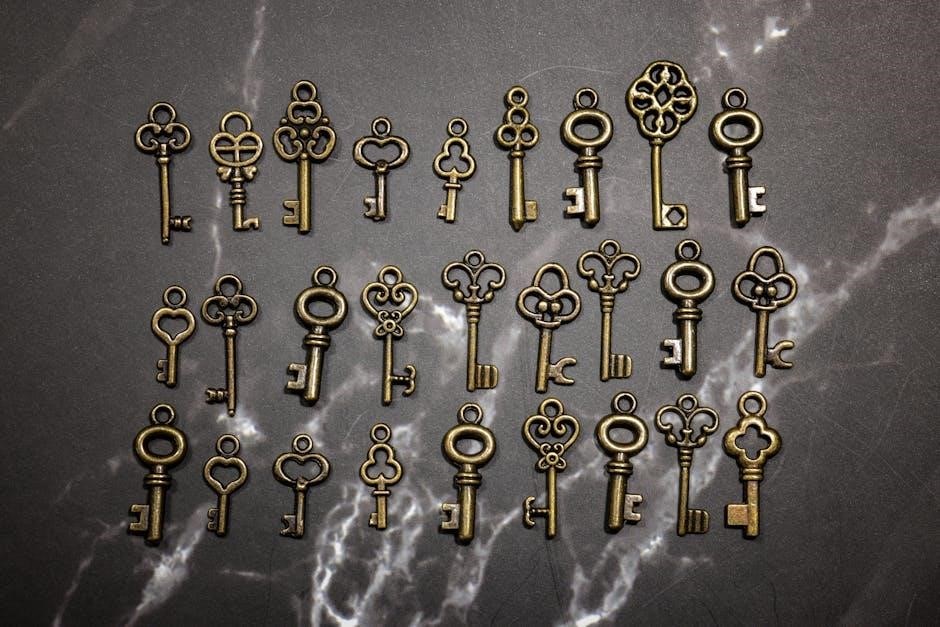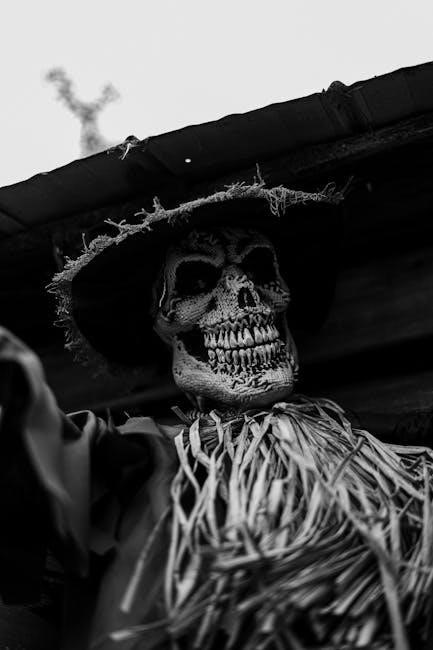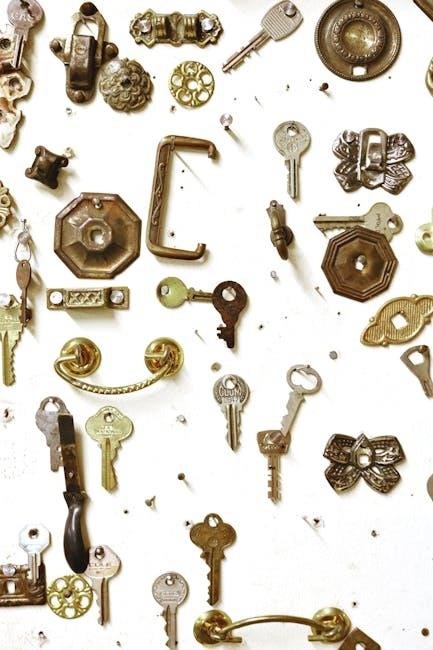
Skeleton keys are tools with ward cuts in every position, bypassing warded locks. Not all bit or master keys qualify as skeleton keys. Identification involves analyzing historical designs, barrel shapes, and bit configurations. Antique keys often date pre-1940, with some much older. Collectors and locksmiths value understanding key anatomy and historical context to authenticate and classify skeleton keys effectively.
What is a Skeleton Key?
A skeleton key is a specialized tool designed to bypass warded locks by having ward cuts in every possible position. Unlike standard keys, it can open multiple locks with similar warding configurations. Historically, skeleton keys were essential for locksmiths and maintenance workers. Today, they are often collected for their historical and mechanical significance. Skeleton keys differ from master keys, as they operate through warding systems rather than pin tumbler mechanisms. Their unique design allows access to various locks, making them both functional and sought after by enthusiasts and collectors.
Historical Significance of Skeleton Keys
Skeleton keys hold a rich historical significance, dating back to medieval times when warded locks were prevalent. These keys were essential tools for locksmiths, allowing them to bypass warding mechanisms and access locks. During the 18th and 19th centuries, skeleton keys became synonymous with locksmithing craftsmanship. Their use declined with the advent of pin-tumbler locks in the 20th century. Historically, skeleton keys symbolized access and control, often used by maintenance staff, caretakers, and institutions. Today, they are cherished by collectors for their historical and mechanical intrigue, representing a bygone era of lock design and security.
Why Identify Skeleton Keys?
Identifying skeleton keys is crucial for understanding their historical and functional significance. Collectors and historians benefit from knowing a key’s origin, age, and purpose, which aids in preserving historical artifacts and understanding past locking mechanisms. Identification helps determine a key’s value, whether for collection, restoration, or security assessments. It also assists in maintaining old locks or furniture, ensuring they function properly. Additionally, knowing the specific use and history of a skeleton key can prevent misuse and ensure compliance with legal regulations. This knowledge enhances appreciation for craftsmanship and historical context, making identification essential for enthusiasts and professionals alike.

Understanding Skeleton Key Anatomy
A skeleton key’s anatomy includes a handle, barrel, bit, and shaft, each serving specific functions. The handle provides grip, while the barrel houses the internal mechanism. The bit interacts with the lock’s wards, and the shaft aligns the key properly. Understanding these components is essential for identification and functionality.

Key Components of a Skeleton Key
A skeleton key consists of several essential components: the handle, barrel, bit, and shaft. The handle provides a grip for turning, while the barrel encases the key’s internal mechanism. The bit is the working end, shaped to bypass or interact with a lock’s wards. The shaft connects the bit to the handle, ensuring proper alignment. Some keys may also feature a collar, adding durability and control. Understanding these components is crucial for identification, as their design and condition can reveal the key’s age, origin, and intended use.
The Role of the Bit in Skeleton Keys
The bit is the functional end of a skeleton key, designed to engage with a lock’s mechanism. Its unique shape allows it to bypass or lift wards inside the lock, enabling the key to turn. The bit’s design varies depending on the lock it is intended to open, with some featuring intricate notches or cuts. The bit’s condition and wear can indicate the key’s age and usage history. In identification, the bit’s shape and complexity are critical for determining the key’s origin and purpose. A well-preserved bit often signifies a key’s historical or functional significance.
Barrel and Handle Design in Skeleton Keys
The barrel and handle are essential components of a skeleton key, influencing both functionality and aesthetics. The barrel, or shank, connects the bit to the handle and is typically cylindrical. Its length and thickness vary, accommodating different locks. Handles are often decorative, reflecting historical styles like Victorian or Art Nouveau. Materials such as brass, iron, or even ornate finishes were commonly used. The design can indicate the key’s age or origin, with intricate details signifying craftsmanship. The barrel and handle’s condition and design aid in identification, providing clues about the key’s historical context and intended use.

How Skeleton Keys Work
Skeleton keys operate by inserting the bit into a lock, aligning it with internal wards, and applying rotational force to open the mechanism.
Mechanism of Skeleton Keys
Skeleton keys function by bypassing the security features of older locks, particularly warded locks. Their reduced design allows them to navigate past internal wards, engaging the lock’s mechanism. The bit aligns with the lock’s internal configuration, enabling rotation to open the lock. Historically, skeleton keys were used before modern pin-tumbler locks became prevalent. The bit’s shape is crucial, as it must match the lock’s wards to lift or move the bolt effectively. This design allows a single key to operate multiple locks, making them valuable for access in older buildings or systems. Understanding this mechanism aids in identifying and using skeleton keys appropriately.
Warded vs. Skeleton Keys: Key Differences
Warded and skeleton keys differ significantly in design and functionality. Warded keys have a complex shape to navigate internal lock wards, ensuring only the correct key fits. Skeleton keys, however, are simplified, with most material removed, allowing them to bypass wards and operate multiple locks. Warded keys offer more security due to their unique warding system, while skeleton keys prioritize versatility. Historically, skeleton keys were used as master keys in older locking systems, whereas warded keys were standard for individual locks. This distinction highlights their contrasting purposes in lock mechanisms, making them distinct in both application and historical context.
Modern Applications of Skeleton Keys
Skeleton keys remain relevant in modern times, particularly in niche applications. They are often used by locksmiths for emergency access or to bypass worn-out locks. Collectors and enthusiasts value them for their historical significance and craftsmanship. Additionally, skeleton keys are employed in restoration projects to maintain the functionality of antique locks. Some industries, like hospitality, use them for master key systems in historic buildings. Hobbyists and educators also utilize skeleton keys to demonstrate locking mechanisms. Their versatility ensures they remain a practical tool in various contexts, blending historical charm with functional utility in contemporary settings.

Historical Evolution of Skeleton Keys
Skeleton keys have evolved from ancient tools to sophisticated instruments, reflecting advancements in lock technology and societal needs over centuries.
Origins of Skeleton Keys
Skeleton keys trace their origins to ancient civilizations, with early examples found in Egypt and Rome. These primitive keys were simple tools designed to manipulate basic locking mechanisms. The term “skeleton” reflects their minimalistic design, focusing on essential features for functionality. Early skeleton keys were crafted by blacksmiths, serving as versatile instruments to bypass warded locks. Their development paralleled advancements in locksmithing, becoming indispensable for accessing multiple locks with a single key. Over time, their design refined, but their core purpose remained unchanged, laying the foundation for modern skeleton keys. These early tools represent the precursor to the sophisticated keys seen today.
Evolution of Skeleton Key Design
The design of skeleton keys evolved significantly over centuries, adapting to advancements in locking mechanisms. During the Middle Ages, blacksmiths refined their craftsmanship, creating more precise tools. The Industrial Revolution brought mass production techniques, standardizing skeleton keys and improving their durability. As locks became more complex, skeleton keys incorporated intricate bit designs to bypass warding systems effectively. Materials like brass and steel replaced iron, enhancing strength. By the 19th century, skeleton keys became more specialized, catering to specific lock types. Despite the rise of modern locking systems, the fundamental design of skeleton keys has persisted, reflecting their enduring utility in locksmithing traditions.
Decline of Skeleton Keys in Modern Times
The decline of skeleton keys in modern times is attributed to advancements in lock technology and security measures. Contemporary locks often feature pin tumbler mechanisms, which skeleton keys cannot bypass. The rise of digital locks, keycards, and biometric systems has further reduced their relevance. Additionally, the legal and ethical concerns surrounding skeleton keys have limited their practical applications. While they remain collectible items for enthusiasts and historical purposes, their functional role in everyday locksmithing has diminished significantly. Modern locksmithing emphasizes electronic and high-security solutions, leaving skeleton keys largely as relics of the past.

Types of Skeleton Keys
Skeleton keys are categorized into antique, modern, and specialized types, each crafted with unique materials and techniques, and reflecting distinct purposes across different eras.
Antique Skeleton Keys
Antique skeleton keys are highly sought after by collectors for their historical significance and craftsmanship. Typically dating back to the 18th and 19th centuries, these keys were handcrafted with intricate details and ornate designs. Made from materials like brass, iron, or bronze, they often feature decorative handles and complex bit patterns. Many antique skeleton keys were used in warded locks, a common locking mechanism of the time. Collectors value them for their rarity,Condition, and historical stories. Some keys are linked to specific estates or time periods, making them treasured possessions for enthusiasts of antiquity and locksmithing history.
Modern Skeleton Keys
Modern skeleton keys are precision-engineered tools designed for contemporary locksmithing needs. Unlike their antique counterparts, they are typically made from durable materials like stainless steel or titanium, ensuring longevity and resistance to wear. These keys are often used by professional locksmiths for accessing modern warded locks or master key systems. Their sleek, minimalist design contrasts with the ornate details of older keys, focusing on functionality over aesthetics. Modern skeleton keys are also collectible, appealing to enthusiasts who appreciate their practicality and engineering. They remain essential tools in the locksmithing trade, blending historical techniques with modern manufacturing advancements for reliable performance.
Specialized Skeleton Keys
Specialized skeleton keys are tailored for specific applications, often catering to niche industries or unique locking systems. These keys are crafted with precision, featuring intricate designs that address particular security mechanisms. Unlike standard skeleton keys, they may incorporate advanced materials or custom bit configurations. Some are designed for historical locks, aiding in restoration projects, while others serve specialized trades like safe-cracking or high-security systems. Enthusiasts and collectors prize these keys for their rarity and craftsmanship. Their functionality extends beyond general use, making them invaluable in specific contexts. Specialized skeleton keys highlight the adaptability and ingenuity in locksmithing, blending tradition with modern innovation for precise lock operation.

A comprehensive guide to identifying skeleton keys involves visual inspection, historical research, and professional valuation. It helps enthusiasts and collectors understand key characteristics, historical origins, and market value.
Visual Inspection Techniques
Visual inspection is crucial for identifying skeleton keys. Examine the handle material, such as brass or iron, and the craftsmanship. Look at the barrel and bit for unique features. The shape and arrangement of teeth can indicate historical period or lock type. Use magnification to spot engravings or serial numbers. Compare with known examples to determine authenticity. This method helps enthusiasts and professionals alike in understanding and valuing skeleton keys. Some handles feature intricate designs, while others are plain. The barrel may show signs of aging or manufacturing techniques. These details help in dating the key. Understanding these visual elements is essential for accurate identification and appreciation of skeleton keys.
Historical Research for Identification
Historical research is vital for accurately identifying skeleton keys. Study the era and region where the key was likely made, as designs often reflect period-specific craftsmanship. Consult historical records, manufacturer databases, and museum collections to trace the key’s origins. Compare the key’s features with documented examples from the same time frame. Research locksmithing texts and catalogs from the 18th and 19th centuries, as these often detail key designs. Analyze the materials and manufacturing techniques used, which can indicate its age and purpose. This method helps enthusiasts and collectors understand the key’s historical context, enhancing its value and significance. Proper research ensures authenticity and provides a deeper appreciation of the key’s history.
Professional Valuation of Skeleton Keys
Professional valuation is essential for determining the worth of skeleton keys, especially for rare or antique pieces. Consult reputable appraisers or locksmithing experts who specialize in historical items. Provide detailed documentation, including historical research and provenance, to support the key’s authenticity and value. Experts will assess factors like condition, rarity, and historical significance. Consider obtaining a written appraisal for insurance or sale purposes. Professional valuation ensures an accurate and unbiased assessment, helping collectors and enthusiasts understand the key’s monetary and historical worth. This step is crucial for making informed decisions regarding ownership, sale, or preservation of skeleton keys.

Usage and Maintenance
Proper handling and care are vital to maintain a skeleton key’s functionality and value. Regular cleaning, storage in dry conditions, and avoiding forced use preserve its integrity; Understanding historical mechanisms ensures safe operation for collectors and enthusiasts, while routine maintenance prevents corrosion and wear, ensuring longevity and reliability over time.
Using Skeleton Keys Safely
Using skeleton keys safely requires careful handling to avoid damage or injury. Always inspect the key for wear or rust before use, as weakened components can break under stress. Apply gentle, consistent pressure to prevent snapping or bending; Ensure the key aligns properly with the lock to avoid forcing it, which can harm both the key and the mechanism. Wear protective gloves to maintain grip and protect against sharp edges. Use skeleton keys in well-lit environments to ensure accurate alignment. Avoid using keys in damp conditions to prevent rust. Store keys in a dry place when not in use to maintain their integrity. Cleaning the key gently with a soft cloth can also prevent corrosion. By following these guidelines, you can ensure safe and effective use of skeleton keys while preserving their condition for future use.
Maintenance Tips for Skeleton Keys
To maintain skeleton keys, clean them regularly using a soft cloth and mild detergent to remove dirt and grime. Avoid harsh chemicals that could damage the metal. Lightly oil the bit and barrel to prevent rust and ensure smooth operation. Store keys in a dry, cool place to avoid corrosion. Handle keys with care to prevent bending or breaking, especially antique or fragile examples. For rusted keys, gently scrub with fine sandpaper and oil afterward. Regularly inspect for wear and address issues promptly. Proper maintenance ensures longevity and functionality, preserving your skeleton keys for years to come.
Storage and Preservation
Proper storage and preservation are crucial for maintaining the condition of skeleton keys. Store them in a cool, dry place away from direct sunlight to prevent fading or warping. Use airtight containers or cases with soft linings to protect against moisture and scratches. For multiple keys, organize them in labeled compartments or on key rings with protective coverings. Avoid exposing keys to extreme temperatures or humidity, as this can cause rust or corrosion. Consider using silica gel packets to control humidity levels. Regularly inspect stored keys for signs of damage or deterioration. Proper preservation ensures the longevity and integrity of your skeleton keys.

Legal and Ethical Considerations
Skeleton keys raise legal and ethical concerns due to their potential for unauthorized access. Laws vary by region, but possession and use may require permits. Ethical use demands responsible handling and respect for property rights. Misuse can lead to legal consequences. Always ensure compliance with local regulations and moral standards when dealing with skeleton keys.
Legality of Skeleton Keys
The legality of skeleton keys varies by region, with many jurisdictions imposing strict regulations. In some areas, possession without proper authorization is illegal, while others require permits for ownership. Misuse, such as unauthorized access to property, can lead to criminal charges. Laws often target the intent behind possession, distinguishing collectors from individuals with malicious intent. Historical or antique skeleton keys may be exempt from certain restrictions. It’s essential to consult local laws to ensure compliance, as penalties can include fines or imprisonment. Understanding legal boundaries is crucial for responsible ownership and use of skeleton keys.
Ethical Use of Skeleton Keys
Ethical use of skeleton keys revolves around responsible and lawful behavior. Collectors and users should prioritize transparency, ensuring keys are used for legitimate purposes like historical preservation or authorized access. Misusing skeleton keys for unauthorized entry or malicious intent violates ethical standards. Ethical practices emphasize respecting privacy and property rights, aligning actions with legal and moral frameworks. Collectors should document ownership and use keys responsibly, avoiding harm to others or property. Ethical considerations also extend to preserving historical integrity when dealing with antique keys, ensuring their cultural significance is honored. Responsible stewardship is key to maintaining trust and respect in the use of skeleton keys.
Responsibility in Owning Skeleton Keys
Responsible ownership of skeleton keys involves proper storage, safe handling, and awareness of their potential risks. Owners should ensure keys are kept secure to prevent misuse by unauthorized individuals. Regular inspection for wear and tear is essential to maintain functionality and safety. Historical or antique keys should be treated with care to preserve their condition and cultural value. Understanding local laws regarding key ownership is crucial to avoid legal complications. Collectors and users must also respect the historical context of their keys, avoiding actions that could tarnish their heritage. Responsible ownership fosters trust and ensures the keys remain tools of heritage rather than instruments of harm.

Resources and Tools
Essential tools for skeleton key identification include magnifying glasses, reference guides, and online databases. Specialized locksmithing tools and historical archives also aid in accurate identification processes.
Recommended Tools for Skeleton Key Identification
Identifying skeleton keys requires specific tools to ensure accuracy. A magnifying glass or jeweler’s loupe is essential for examining intricate details like teeth patterns and bitting. A reference guide or catalog of historical keys can help compare and match designs. Calipers are useful for measuring key lengths and widths. A multimeter can test for electrical conductivity in modern skeleton keys. A digital microscope provides high-resolution images for detailed analysis. Additionally, a key bit depth gauge and skeleton key gauge can measure bitting depths and barrel diameters. Proper lighting, such as a UV lamp, can reveal hidden markings or engravings.
Online Resources for Skeleton Key Enthusiasts
Online resources are invaluable for skeleton key enthusiasts, offering a wealth of information and community support. Websites like Reddit’s locksmithing community and specialized forums provide forums for discussing key identification and history. Online databases, such as The Keyhole, catalog historical keys with high-quality images. Social media groups dedicated to key collecting share tips and showcase rare finds. Additionally, online marketplaces like Etsy and eBay offer access to rare skeleton keys for study or collection. Educational websites, such as The Locksmith’s Guild, provide tutorials and historical insights. These resources help enthusiasts enhance their knowledge and connect with like-minded individuals globally.
Workshops and Communities
Workshops and communities are essential for enthusiasts seeking hands-on experience and expert guidance in skeleton key identification. Local locksmithing workshops often offer sessions on historical key mechanisms and restoration techniques. Online communities, such as The Skeleton Key Collector’s Group, foster collaboration and knowledge sharing. Annual events like The Locksmith’s Guild Conference provide networking opportunities with experts. These platforms allow enthusiasts to learn from seasoned collectors, participate in hands-on training, and gain insight into rare and unique skeleton keys. Engaging with these groups enhances both identification skills and appreciation for the craftsmanship behind skeleton keys.